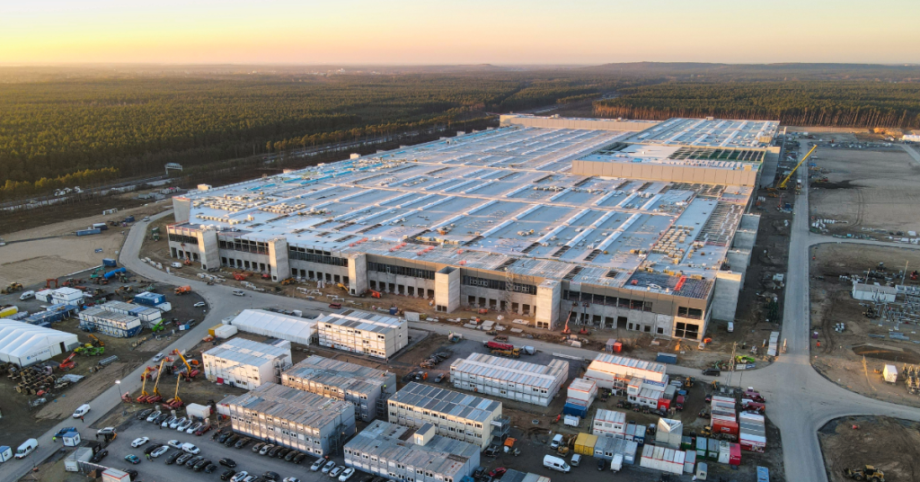As the use of electric vehicles (EVs) becomes increasingly prevalent, demand for batteries is set to rise at an exponential rate. To meet this demand, we are seeing the development of more and more gigafactories across the world.
Coined by the EV manufacturer Tesla, the term “gigafactory” has now also been adopted by other companies in the EV and clean tech sector to refer generally to any large battery manufacturing plant.
Worldwide gigafactories
Currently, China dominates the gigafactory scene, with 82% of the world’s gigafactory capacity. However, Europe is set to be home to a more significant proportion of the world’s gigafactories by 2030. Germany is at the centre of the European battery boom, with several automotive manufacturers from across the globe (including Tesla and CATL) choosing to expand into the country. Northvolt, one of Europe’s major battery makers, is set to build its third gigafactory (Northvolt Drei) in Heide, Germany, which will complement its existing factories in Sweden and Poland.
Not to be left out, the UK has been chosen as the home of the first gigafactory for the Tata Group (the owner of Jaguar Land Rover) outside of India. Whilst this will provide a significant boost to the UK battery manufacturing capacity, the Faraday Institution estimates that by 2040, ten gigafactories will be needed in the UK to support battery demand for private cars, commercial vehicles, HGVs, buses, micromobility and grid storage. It therefore seems that this will be one of several gigafactories developed in the UK over the next ~15 years. Indeed, at the end of 2023, it was announced that Japanese firm Nissan plans to build an electric car plant in Sunderland, which will require the development of a new gigafactory.
As the prefix “giga” suggests (being derived from the Greek word gigas meaning “giant”), a gigafactory is simply a huge battery factory, producing a great amount of energy capacity per year. In general, battery manufacturing is broken down into three main steps: electrode manufacturing, cell assembly and conditioning. Each step of the manufacturing process provides the opportunity for innovation and thus IP protection.
Patent protection of products & processes
So, how do we go about protecting what can be diverse and complex battery products and their manufacturing processes?
Patent claims can broadly be split into two categories: claims to a physical entity (product claims and apparatus claims) and claims to an activity (process and use claims). When it comes to battery manufacture, we therefore have two fundamental concepts which can be protected.
For example, a process claim may recite one or more steps of a method of manufacturing a battery (or a constituent part thereof) in a gigafactory, including the important features of each step, at least one of which should make the method novel and inventive. Such a claim may take the general form of a process for making X, said process comprising steps i, ii and iii.
Beneficially, for the purposes of infringement, EPO law provides that the protection afforded by a process claim is extended to “products directly obtained by such process”, as well as protecting the process itself.
With regard to a product claim, e.g. the battery itself or a constituent part of it, the EPO normally requires that these products are defined in terms of technical features or physical characteristics. For example, a new cathode material may be defined in terms of its composition, giving a claim taking the form of a product X comprising features a, b and c.
However, sometimes it is required to rely on a process-based definition of a product, by reference to the way in which it has been made. This often occurs when a material itself cannot be easily defined, or if a purely structural definition is too narrow to capture the true scope of the invention. A claim that is directed to a product but defined in terms of its method of manufacture is known as a product-by-process claim, typically taking the hybrid claim form of a product X obtainable by the steps i, ii and iii.
Whilst some jurisdictions raise little objection to products defined in this way, the EPO considers product-by-process claims to be directed to the product itself, and not actually limited by the method used to make it. Therefore, the patentability of the claim similarly lies in the novelty and inventiveness of the product (rather than the process), and the burden of proof lies with the applicant to establish this. To do this, experimental data may be required, such as reproductions of earlier known methods, which may be difficult or even impossible.
Nevertheless, if these patentability difficulties (particularly in Europe) can be overcome, then a product-by-process claim can provide a patentee with a useful scope of protection. A product-by-process claim allows for the protection of the product as obtained by any method provided that it may be obtained by the claimed steps. Clearly, this may represent a more beneficial, and more enforceable, scope of protection than relying on the extension of protection of a process claim strictly to products directly obtained by the particular process (as discussed above).
What does this all mean?
The term “gigafactory” is likely to remain a buzzword for years to come. Battery innovation is booming in response to net zero commitments and the desire for greater battery capacity and efficiency, as well as faster charging and longer lifetimes. IP protection in this field has therefore never been more important.
In such a relevant but busy space, the need to demonstrate novelty and inventiveness of batteries and their methods of manufacture becomes even more acute. With our knowledge and experience in battery technology, the Mewburn Ellis energy storage team understand the importance of a strong IP position and are well equipped to provide support and advice. Whether you are at the very start of your IP journey, or whether you are already approaching “giga” scale, feel free to get in touch with us.



